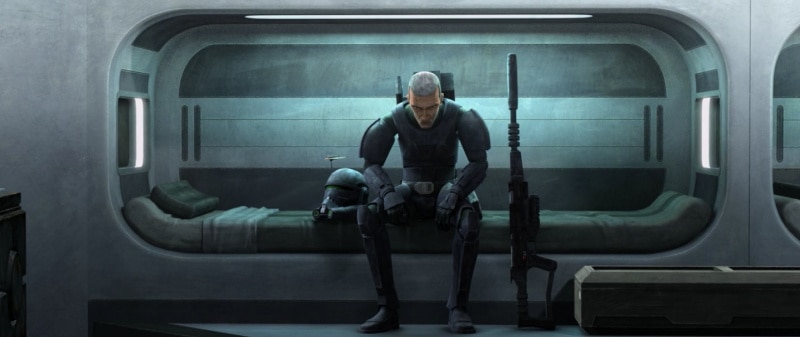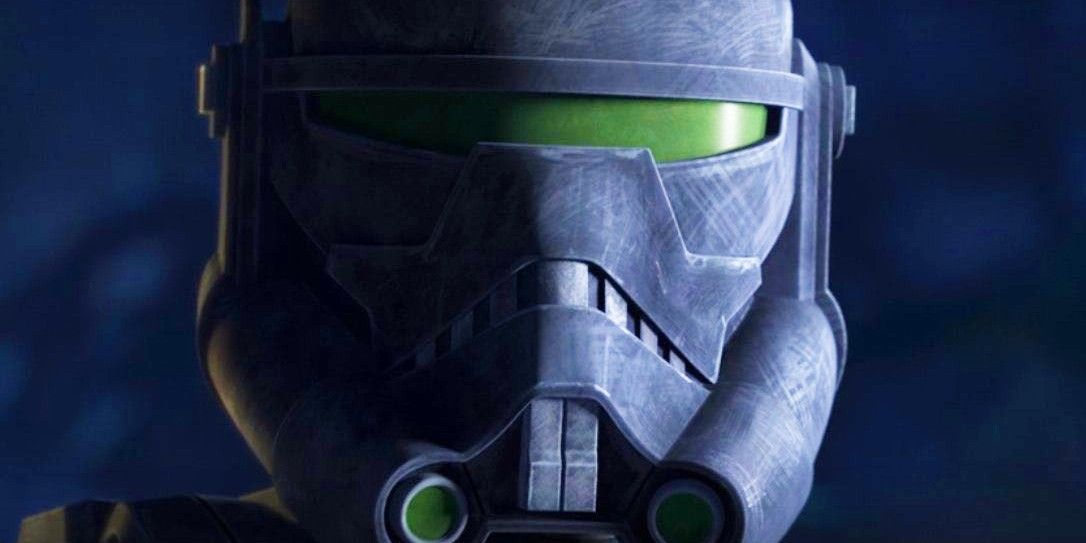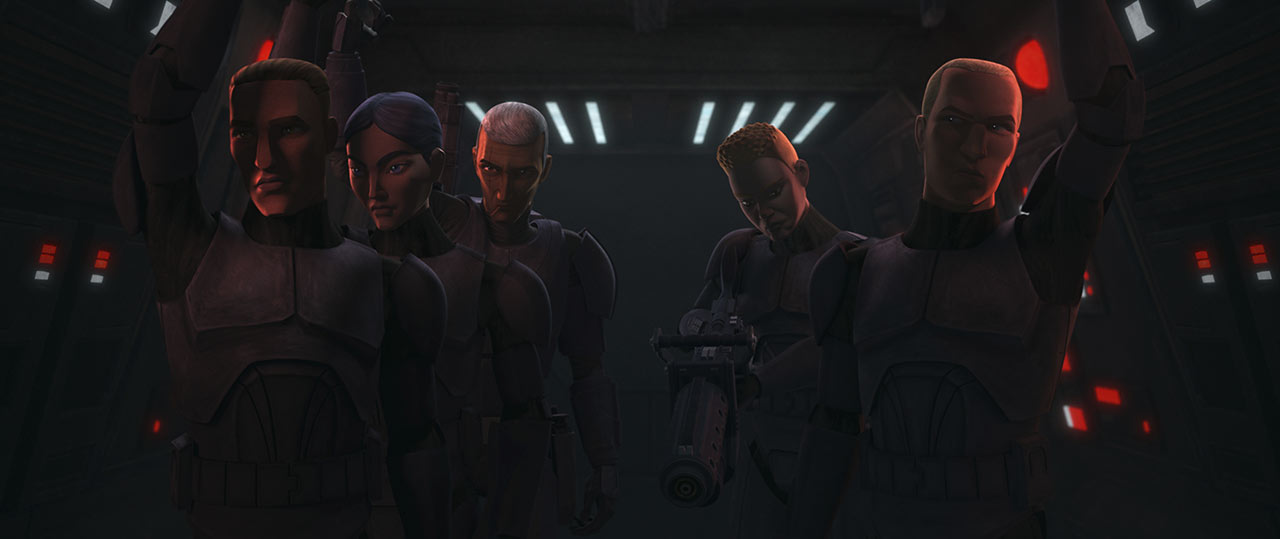Another week, and another episode of The Bad Batch. Let’s dive right on in!
The Plot

This third episode splits into A and B plots for the first time.
Plot A focuses on Crosshair. We see him in his grey undersuit against a sterile environment while Governor Tarkin discusses him with the Kaminoans outside the examination room. What appears to be a droid who is either AZ1-3 or a similar model lets Crosshair know he’s in optimal health.
Tarkin, anxious to find the right kind of army best suited to establish the new Empire’s control at sustainable cost, discusses the future of the clone program with anxious Kaminoans who may lose one of their most profitable contracts due to Tarkin’s anti-clone tendencies.
Rampart, an Imperial officer, enters the scene with an alternative: soldiers who volunteer to enlist in the Empire’s service. He believes that these soldiers trained and led by skilled clones will provide the perfect solution to Tarkin’s problem. To test Rampart’s proposed solution, Tarkin sends Crosshair and his new group of soldiers to dispatch Saw Gerrera, the mission the Bad Batch failed to complete in the premier episode.
When they find Gerrera’s camp, only a handful of fighters and civilians remain as they load a shuttle to depart Onderon. After killing the fighters and incapacitating the shuttle, Crosshair and his squad circle the remaining civilians, questioning them regarding Gerrera’s whereabouts. When it’s clear they don’t know where Gerrrera is, Crosshair orders the civilians to be killed. One of the new soldiers declines to follow the order, and Crosshair kills him for it. A fade to black hides the surviving soldiers slaughtering the civilians.
Meanwhile, the Kaminoans seek to prevent the impending doom of their clone program. Though they keep referring to conscripted soldiers, Rampart’s program relies on volunteer soldiers, so it sounds like the Kaminonas are in a state of denial. They speak cryptically to each other, reference the degradation of Jango Fett’s genetic material, and mention an experiment yielding a superior clone, for which they need additional source material and certain clones to return. Based on the tenses used, it sounds like the superior clone does not yet exist, making Omega an unlikely candidate. For the clones that need to return, they only need one, which makes the Bad Batch unlikely candidates for that part of the equation since the Kaminoans already have Crosshair.
Plot B focuses on the remaining Bad Batch with Omega. Their ship, damaged during their escape from Saleucami, crash lands on a moon’s surface. They need to repair the ship while facing off against a small dragon that feeds off energy.
The Good

Crosshair returning to focus was most welcome. The deteriorating effects of the chip to Crosshair’s character comes into stark light, even as Omega clarifies that the chip is likely responsible for Crosshair’s actions, inspiring Hunter to feel guilt at leaving him behind.
Still, it is hard for the viewer to watch Crosshair once again utter, “Good soldiers follow orders,” as he commands his new squad to kill civilians. He is relentless, murdering even one of his own squad members who said he had signed up to be a soldier, not an executioner. Crosshair’s actions underscore his belief that wiping out the entire camp, fighters and civilians alike, was their true mission.
All soldiers are executioners is the necessary conclusion viewers must draw from this scene.
Crosshair provides a subtle commentary on the nature of empire. What do empires do but take, occupy, and kill? As Palpatine, via Tarkin, flexes the power of his new Empire, it builds upon its foundation. After all, the Clone Wars appeared to begin with the slaughter of the Jedi on Geonosis, culminating in the slaughter of the Jedi via Order 66 as clones, fodder for the engine of war, turned upon their Jedi generals because of the inhibitor chip.
And yet, those were not the first deaths to pave the way for the Empire. A million smaller, unnoticeable deaths set the stage. One of the soldiers Rampart brought in said that he was being paid, fed, and housed by the Empire which was more than the Republic had ever done for him. It’s under the influence of both the Jedi and the Republic that slavery is allowed to exist on the outer rim planets, where a young Anakin can say that another chip, embedded in skin, will “BOOM! Blow you up” if a slave should attempt escape.
The Republic, like the Empire that blooms from its composting carcass, was built on death.
The ghastly truth is that the soldier is wrong while Crosshair is right. Their mission has always been to execute civilians whether that be by blaster or the suppression of resources that allow civilians to live and thrive in their own homes on their own planets.
Throughout every Star Wars story, this is shown. The dispossessed and starving die as the Empire strips Lothal of its natural resources. In the lower levels of Coruscant, Ahsoka witnesses the struggle to survive.
Who doesn’t survive is the question asked in the negative spaces of the story, sometimes dragged into light as when the viewer witnesses the death of Steela Gerrera, a single death amongst many against the backdrop of conflict carried out by Separatist factions, Republic order, and crime bosses like the Hutts. Each player carves out its own purpose of death and consumption, fanfare for the Empire’s rise, the same Empire that ordered the destruction of Jedha, which in turn was dress rehearsal for the annihilation of Alderaan.
Over in Plot B, the emotional themes focus more or less on the idea of home. It’s mentioned at the beginning of the episode that Omega doesn’t have a room of her own. At the end, Wrecker makes one for her. Similarly, Hunter is at first reluctant to bring Omega along as he goes to retrieve a part they need for a ship from the scavenging dragon, but she accompanies him, and finds her place in their squad when Hunter is rendered injured. It is Omega who brings Hunter’s blaster and follows the dragon to its lair of scrap metal and procures the part. She could have killed the dragon at this point, but she chooses not to — a choice made even more emphatic as it parallels Crosshair’s choice to execute civilian and disobedient soldier alike.
Whereas Omega marvels at a room of her own, a room aglow with warmth and family, Crosshair returns to his old quarters with what remains of his squad. Though they are together, they are apart, and stare at each other across a chasm of violence. There is no familial warmth for Crosshair. There is only himself and the ghost of what he’s done. He is entirely alone, even though physically, he isn’t.
The episode hinted significantly that another clone will be joining Crosshair’s struggle with their inhibitor chip. Several times, Wrecker grips his head on the right side, saying it hurts, and attributing it to the crash landing. However, the side he holds is where both Fives’ and Rex’s chips were shown to reside. I suspect a reckoning with Wrecker’s chip is not far off on the horizon.
The Bad

This third episode is the weakest so far. I don’t think it’s necessarily realistic for each episode to be stronger than the last, but I was disappointed at the lack of risk or emotional stakes in the B plot, which was significantly weaker than A plot to the episode’s detriment.
As always, I am disappointed in how Star Wars treats race. Rampart’s first elite squad of soldiers are racially diverse, including a Black woman, a Black man, an Asian woman, and a white man. They exist in stark contrast to the whitewashed clones, almost a token gesture that Star Wars isn’t rife with racism or white supremacy, when in reality Disney could have had it both ways: the Bad Batch not whitewashed and the characters introduced in this new squad. Even so, the existence of diverse characters is not enough to outweigh their treatment in a story. Even though it’s likely the white man whom Crosshair executes, he is also the one with the most lines and the most choices in comparison to the others, and that’s a problem too.
Though I want to avoid an analysis that hinges on a diversity checklist, the creators in Star Wars should be asking themselves the hard questions about who gets to have significant storylines, and who doesn’t.
Star Wars must also grapple with its treatment of women in the series, specifically women of color, and Black women in particular.
I hope that we’ll see more of the women in this new squad, but Disney and Lucasfilm have not earned my trust in this matter, and their scenes here also did not inspire confidence. To read more about the lack of Black women in Star Wars, I recommend reading this article. Here’s hoping this currently unnamed Black woman will have a more significant role in subsequent episodes.
In Conclusion

Even though “Replacements” was a bit of a let down in comparison to the earlier episodes, I still enjoyed it for the most part. If I had to choose between the plot threads that this episode planted, I’m going with the potentiality of Wrecker’s chips causing a little havoc. Perhaps the writers will take the opportunity to complicate Wrecker’s character as well.